A while back, Birgit and I had a short discussion in the comment section about “Transcendental Art” but neither one of us were unable to expand upon the subject in a satisfactory way at the time.
I checked out the clippings from that long ago art magazine article and found, happily, that there is in fact an artist’s name listed with the art work. And I’m also happy to report that my Art History degree has paid off because after all these years I recognized the name of the artist.
So without further ado, the artist is…Richard Pousette-Dart (1916-1992).
Richard Pousette-Dart was an early member of the Abstract Expressionist movement that reached its apex in 1950s New York, and was not a stranger to Peggy Guggenheim’s This Century art gallery. He is one of the figures in the famous, and preciously titled, Life photograph The Irascibles, standing alongside de Kooning and Pollack.
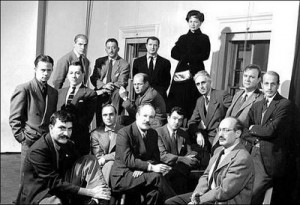
Pousett-Dart on far left, second row
Despite his early association with this group, claiming Pousette-Dart is an Abstract Expressionist is putting a round hole in a square peg. However, his influence on artists such as de Kooning and Pollack is unmistakable. Pousette-Dart was also the first of these artists to create art on a large scale, something Pollack would do later to great effect.
One of de Kooning’s greatest works is Excavation. And while it may seem tenuous at first, I believe Pousette-Dart’s influence is evident, as one can see here in the early Pousette-Dart piece Desert from 1940 which was made ten years before de Kooning’s Excavation.
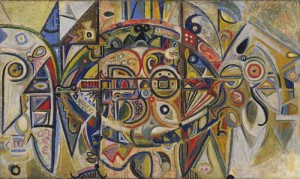
Desert 1940
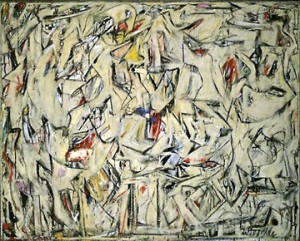
Excavation 1950
Pousette-Dart was influenced at a fairly young age by the works of Jung and Freud, Northwest Indian culture and European Modernism. His body of work is an amalgam of these and more. Today one could be tempted to call it New Age but I feel that would weaken its meaning, given the heavy baggage the term New Age carries.
On his artistic journey he traveled through, in no particular order, the Modern art movements of Abstract Expressionism, Symbolism, Surrealism, Color Field painting and neo-Pointillism.
Pousette-Dart’s primary goal was to experience spiritual transcendence and expanded consciousness through the creation of his art, as well as the viewing of it. He believed that the spiritual was ever present.
Spirituality has many outlets, one of them being esotericism. Esoteric beliefs rely on symbols as teaching methods, the idea being that these symbols are ancient forms of communication which unveil profound truths to those that unlock their meanings.
Pousette-Dart’s work often uses symbols to describe the spiritual. In Desert one sees, although maybe not immediately, the eye at the center of the painting. There are also other, stylized eyes seen in the painting. More than likely in this case the large central eye is the Eye of Providence, also known as the all seeing eye of God, which is often surrounded by rays of light. This image can be found as far back as ancient Egyptian times, with the eye of Horus, and has been used in many cultures over many different periods, all with the overarching idea of a higher power.
In the esoteric the most basic of shapes can carry multiple meanings so that an eye, a triangle or a square may represent divinity, mathematics, physics and by extension, alchemy. And while Pousette-Dart was not overtly depicting esoteric beliefs, one can never assume a square is just a square in his works.
Light plays an important role in Pousette-Dart’s work, and appropriately so as light is an integral part of any transcendent experience. In the early work Desert, light is depicted primarily through the use of white, but through the years, Pousette-Dart’s imagery becomes overwhelmed by the light, fading into the background then returning in different forms so that the symbol itself is the focal point, often created in a neo-pointillism style as in Eye of Light from 1969.

Chavade, 1951
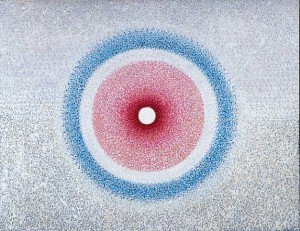
Eye of Light
But where there is light there is darkness, and Pousette-Dart did not shy away from depicting the darkness, in fact he seemed to engage in a rather Manichean depiction of the two such as in his work Wall of Signs.
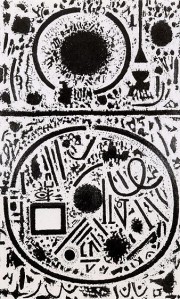
Wall of Signs
Black is used to great effect in his work Presence Number 3, Black from 1969. While the use of black and the word Presence can conjure a feeling of dark foreboding, I am reminded of Malevich’s Black Square. If the square is God, neatly self contained, if at the same time endless, then this is God exploded out into tiny specks, i.e. “us.” Given the large size of the work, I’m sure a physical viewing would also make for an intense experience.
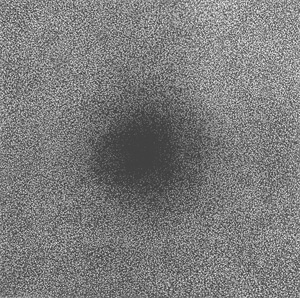
Presence Number 3, Black, detail

Black Square
I believe there are relatively few who speak the true language of spiritual transcendence and expanded consciousness. Often these experiences are cheapened by religion, fake gurus and televangelists. The real experiences are more often than not solitary and inexpressible; as the experiences are so profound there simply are no words to explain them. For those who have had these experiences, viewing much of Pousette-Dart’s work is a silent communion. For those who may not understand that, there is still much to absorb in the way of cultural imagery and symbols as well as a tour through a variety of Modern art styles.

Tree:
Was that the man’s real name? A poussette is a figure in contradancing and Dart could be a variation on D’arte. Together it could be read as ‘Dance of Art”.
Jackson Pollock might have adopted a name like that.
Jay, his father was Nathaniel Pousette-Dart and his mother was Flora Dart, so that apparently was his real name.
I forget whether it was the Guggenheim or the Whitney (I think the Whitney) that had a small exhibition of Pousette-Dart’s work about two years ago. His white-and-graphite pieces were amazing. And yes, a physical viewing did make for an intense experience.
I was also struck by how well he seemed to articulate his vision in words. I wrote out a quotation from one one of the chat labels — “Art is the dynamic edge between the conscious and the unconscious. It is [the] position of transcendental awareness”. That idea of a “dynamic” edge haunts me.
Thanks so much for this post.
I can see why that would haunt you, it’s a really profound statement.
I’m tempted to delve deeper into this works, there’s so much there to explore.
Thanks, Melanie.
Fascinating! I googled some more of Pousette-Dart’s pictures and I really like this book cover.
I am not sure how I relate to esoteric symbols. Have to think about that.
A quotation that I read a couple of days ago and that appeals to me is from Rilke:
I like the Rilke quote, too.
The Pousette-Dart work on the book cover reminds me of some of Turner’s works. I like it, too.
It was difficult writing this because there’s so much one can write about esoteric symbols, metaphysics, etc. Hard to rein it in.
I see esoteric symbols as a shorthand language for the sacred teachings.
Thanks so much for digging this great artist out. Please keep us updated on more works and news about him.
Best regards, Hans
Totally new artist to me. Thanks, Tree.
I suspect I would have liked to have said what Birgit said, both about not being sure about how I relate to esoteric symbols and the Rilke warning she concludes with.
Thanks again for the new visions.
Tree:
Please, I don’t want to put you on the spot, but can you talk a little about the sacred teachings that you mention?
You’re welcome, June.
Jay, I’d be happy to when I get a moment and if I’m able to. However, is there anything in particular you’d like to know? Esotericism? Otherwise, I have a feeling I’m about to stick my head into a big bowl of glue.
Tree:
I just erased a couple of paragraphs as I was fishing. On consideration it may be that you are talking about any given symbol and its connection to a given tradition of thought.
But I would say that the employment of esoteric symbols calls for an audience that is equipped to understand and respond to them. For example, Pousette-Dart might have chosen to express his concept of the dynamic edge with a simple line. The dynamic edge and its inherent meanings would be carried by this symbolism throughout his work. But without my knowing of his chosen meaning a line to me would be but a line.
It’s late and I don’t know if I am making any sense.
Jay makes sense to me. Years ago, I went with a friend to an exhibition of Mondrian. This was, for me, one of those exercises in “I’m going to stand here and stare at this thing until I understand why so many people consider it great.” (I think this echoes my usual confusion about “Why is ____ great and ____ is nothing to write home about when it’s essentially the same thing in different media?” — but I digress).
After wandering around for a while things began to make some kind of sense, and then my friend said: “You can’t see it the way that you see it, you have to see it the way that he sees it.”
There are artists like that — Ann Truitt comes to mind — where you really do need to understand what they were after in order to appreciate what they’ve made whereas with someone who works with more universal signs and symbols (a spiral, a bird, water, mountains, letters, particular colors ) you can bring more of yourself to the piece first, and then quest after the artist’s interest afterward.
Melanie:
And to think that my eyelids were heavy as were my thoughts.
I don’t know of any graphic symbol that carries a meaning understood the same way by every person. Smiles and frowns are read pretty much the same way all over. But I wonder if a drawn circle would be universally chosen as representing the sun?. But, if so, that may be more a matter of similarities than symbolism.
Jay, I agree to a certain point that the use of esoteric symbols calls for an audience who knows what they mean which unfortunately means the artist is preaching to the choir, no pun intended.
Personally, I like art that requires research and a bit of subjective and objective digging in order to understand its meaning.
I think Pousette-Dart often used his own personal language to communicate as have others, Klee being a perfect example.
That brings up a whole host of interesting issues about the limits of language and possibly this is why esoteric symbols exist in the first place so that a simple form evokes a correct and subjective response in the one who sees it.
I don’t know if Pousette-Dart studied esoteric religion or practiced it. I recognize some of his symbols as such. My impression is he was on a spiritual journey and used the methods at hand to try to explain it to others, in the hopes others would see a world infused with light and spirit.
Although, when looking at Wall of Signs and taking into consideration the title, he could be creating an experience where one “hits the wall” and therefore warns that signs can lead one away from the truth as much as lead to it.
What comes up a lot for me in studying his works is Kundalini and the teachings of Gurdjieff, including his sacred dances. These are based on my own experiences and could be lost on another viewer who finds different meanings.
Melanie,
It was a show at the Guggenheim you’re remembering. I think the articles around that may have brought my first real awareness of Pousette-Dart, but my overall impression was not so positive.
Tree has some interesting images here, and I also love this Icarus I came across. Seems a bit like a non-random Pollock. In the Pollock you can imagine there might be all sorts of things, and I do enjoy that, but here you really know there is something.
Steve:
Icarus loops me around to Chihuly in that this painting could be a precursor to C’s practice of squirt-to-draw. In this case it looks rather like P-D is incising into wet paint.
As I remember, the paint in some of the pieces at the –yes, thanks Steve — Guggenheim had paint laid on quite thickly and sculpted. All of which flattens out and is diminished even more than usual by photographic reproduction.
I just saw a notice about this, forgive me if it’s old news to everyone else. The Phillips Collection in D.C. has on an exhibition of Pousette-Dart called Predominately White (through Sept 12). Not surprisingly, it features paintings that are predominately white. The info on the website is well done, and includes a short clip of P-D reading from his notebooks about his work.
http://www.phillipscollection.org/exhibitions/pousette-dart/index.aspx
Melanie,
These pieces are fascinating. First, they made me think of stained glass windows. Then, upon a closer look, they made me think of the geometric shapes of the dunes that I am sketching.
I wish I could make it to DC before September 12.
From the “Wish I’d Known” files — I was just in Delaware last week, which is a stone’s throw from D.C. Woulda… Coulda… Shoulda…
I may indulge myself with the catalog. The white works at the Guggenheim exhibit were breathtaking.
I’m glad you posted this info, Melanie. Granted, I can’t go but still…
I came across the white paintings while writing this piece and thought them intriguing.
ooops. Don’t remember my own name.
Tree:
Pousette-Dart”s painting, as I remember, was at one point cited as an example of how good abstraction should look. His work may have been appreciated by some for appealing to a kind of Oriental ineffability. But then a more effable materiality gained traction, leading to art that speaks to other parts of the mind.
Also, looking at your chosen examples of his art, I get a little deja vu response in that “Black Square” reminds me of Malevich and a number of contemporaneous or subsequent artists who took the unicolor concept to a larger and more lavish extent. It’s just hard to look at “Eye of Light” without flashing back to Nolan who made a bigger and somewhat eclipsing splash with his bullseye paintings. This can be unfair to people like Pousette-Dart who may not have been aware that he was being drawn into competition for the public attention.
I lived around the corner from the Poussette-Darts growing up in Valhalla, NY. Flora was my piano teacher as a child. I remember their big house and the piano so well. I believe Flora drowned or perhaps it was a suicide? Can anyone out there help me find out? I just know that all of a sudden I was told I wouldn’t be going to her for piano lessons any longer because she drowned.
Sorry, Lynn. I know nothing about Flora so I can’t help you.
That’s so interesting that you were neighbors! Thanks for commenting.